Recent Advances in Studies of Molecular Hydrogen against Sepsis
- PMID: 31223285
- PMCID: PMC6567800
- DOI: 10.7150/ijbs.30741
Recent Advances in Studies of Molecular Hydrogen against Sepsis
Abstract
Sepsis is a syndrome comprised of a series of life-threatening organ dysfunctions caused by a maladjusted body response to infection with no effective treatment. Molecular hydrogen is a new type of antioxidant with strong free radical scavenging ability, which has been demonstrated to be effective for treating various diseases, such as infection, trauma, poisoning, organ ischemia-reperfusion, metabolic diseases, and tumors. Molecular hydrogen exerts multiple biological effects involving anti-inflammation, anti-oxidation, anti-apoptosis, anti-shock, and autophagy regulation, which may attenuate the organ and barrier damage caused by sepsis. However, the underlying molecular mechanisms remain elusive, but are likely related to the signaling pathways involved. This review focuses on the research progress and potential mechanisms of molecular hydrogen against sepsis to provide a theoretical basis for clinical treatment.
Keywords: apoptosis; autophagy; molecular hydrogen; oxidative stress; sepsis; shock.
Conflict of interest statement
Competing Interests: The authors have declared that no competing interest exists.
Figures



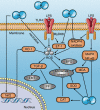
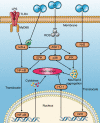
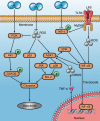
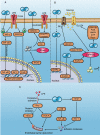
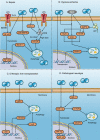
Similar articles
-
Perspective of Molecular Hydrogen in the Treatment of Sepsis.Curr Pharm Des. 2021;27(5):667-678. doi: 10.2174/1381612826666200909124936. Curr Pharm Des. 2021. PMID: 32912119 Review.
-
Recent advances in studies of molecular hydrogen in the treatment of pancreatitis.Life Sci. 2021 Jan 1;264:118641. doi: 10.1016/j.lfs.2020.118641. Epub 2020 Oct 24. Life Sci. 2021. PMID: 33148420 Review.
-
Whey Peptide-Based Formulas With ω-3 Fatty Acids Are Protective in Lipopolysaccharide-Mediated Sepsis.JPEN J Parenter Enteral Nutr. 2015 Jul;39(5):552-61. doi: 10.1177/0148607114520993. Epub 2014 Feb 3. JPEN J Parenter Enteral Nutr. 2015. PMID: 24492312
-
Baicalein protects against polymicrobial sepsis-induced liver injury via inhibition of inflammation and apoptosis in mice.Eur J Pharmacol. 2015 Feb 5;748:45-53. doi: 10.1016/j.ejphar.2014.12.014. Epub 2014 Dec 20. Eur J Pharmacol. 2015. PMID: 25533331
-
Vagus nerve stimulation protects against acute liver injury induced by renal ischemia reperfusion via antioxidant stress and anti-inflammation.Biomed Pharmacother. 2019 Sep;117:109062. doi: 10.1016/j.biopha.2019.109062. Epub 2019 Jun 6. Biomed Pharmacother. 2019. PMID: 31177065
Cited by
-
Magnesium Hydride Ameliorates Endotoxin-Induced Acute Respiratory Distress Syndrome by Inhibiting Inflammation, Oxidative Stress, and Cell Apoptosis.Oxid Med Cell Longev. 2022 Apr 26;2022:5918954. doi: 10.1155/2022/5918954. eCollection 2022. Oxid Med Cell Longev. 2022. PMID: 35528515 Free PMC article.
-
Transcriptomic and metabolomic studies on the protective effect of molecular hydrogen against nuclear electromagnetic pulse-induced brain damage.Front Public Health. 2023 Feb 1;11:1103022. doi: 10.3389/fpubh.2023.1103022. eCollection 2023. Front Public Health. 2023. PMID: 36817910 Free PMC article.
-
Hydrogen in Patients With Corticosteroid-Refractory/Dependent Chronic Graft-Versus-Host-Disease: A Single-Arm, Multicenter, Open-Label, Phase 2 Trial.Front Immunol. 2020 Nov 25;11:598359. doi: 10.3389/fimmu.2020.598359. eCollection 2020. Front Immunol. 2020. PMID: 33324415 Free PMC article.
-
Exploring the Anti-Pulmonary Fibrosis Mechanism of Jingyin Granule by Network Pharmacology Strategy.Front Pharmacol. 2022 Feb 11;13:825667. doi: 10.3389/fphar.2022.825667. eCollection 2022. Front Pharmacol. 2022. PMID: 35222040 Free PMC article.
-
Effect of Hydrogen on AM Pyroptosis Induced by Severe Burns in Rats.J Pers Med. 2023 Feb 21;13(3):377. doi: 10.3390/jpm13030377. J Pers Med. 2023. PMID: 36983559 Free PMC article.
References
-
- Ohsawa I, Ishikawa M, Takahashi K. et al. Hydrogen acts as a therapeutic antioxidant by selectively reducing cytotoxic oxygen radicals. Nat Med. 2007;13:688–94. - PubMed
Publication types
MeSH terms
Substances
LinkOut - more resources
Full Text Sources
Medical

